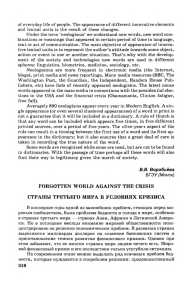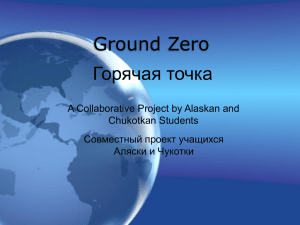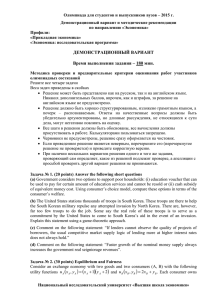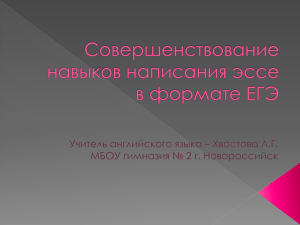презентация - Cloudwatcher
реклама
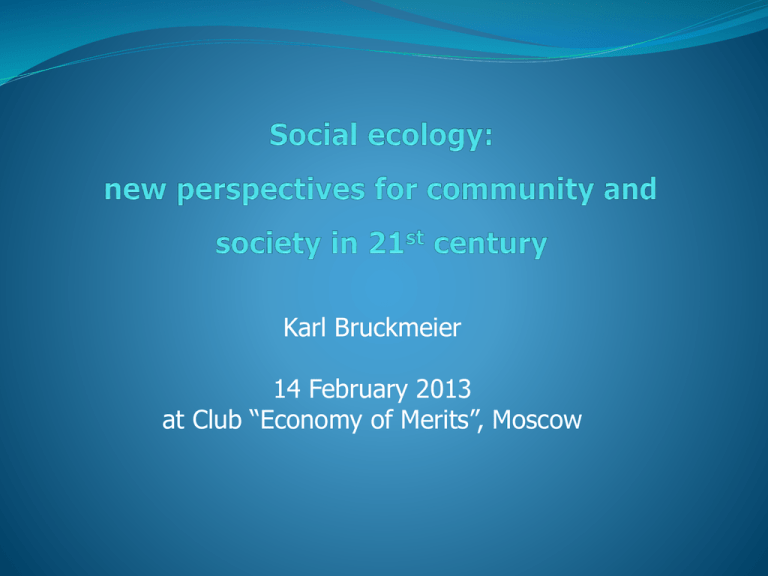
Karl Bruckmeier 14 February 2013 at Club “Economy of Merits”, Moscow Social ecology is … … an interdisciplinary science of the interaction between society and nature Theme: distribution, use and management of natural resources (local to global levels) Aim: producing knowledge to avoid overuse of resources or destruction of the environment Example: the research of Elinor Ostrom 2 Elinor Ostrom Political scientist (1933-2012) University of Indiana at Bloomington, USA Workshop in Political Theory and Policy Analysis (”Bloomington School”) Nobel prize (economics) in 2009 Interdisciplinary research about use of common pool resources and resulting problems (tradition of critical institutional economics) Ostroms research ”in a nutshell” Themes: - ”Communities (of place)”: local groups or communities (e.g., forest users, farmers, fishermen, recreational resource users) - ”Common pool resources”: e.g., fish, wildlife, water - Access and property rights: institutions, rules, regulations for natural resource use - Problems of collective resource use: dilemmas or conflicts between users, how to avoid these and overuse of resources Results: - ”Learning to cooperate”: overuse of resources can be avoided through cooperation (adequate rules and institutions required) - ”No institutional monoculture”: general, standardized, universal solutions to resource use problems (”panacea”, ”cure-all”) inefficient: necessity of locally and culturally specific rules and multi-scale management systems 4 Ostrom - two main research problems: (1) Analysis of rational action … starts from the assumption of ”bounded rationality” (Herbert Simon): human rationality is limited in manifold ways, limits need to be found from empirical research Ostrom: how to integrate 2 contrasting forms of rationality in joint resource use, - individual rationality or the ”pursuit of self interest” and - collective rationality or the capability to cooperate? - Actors need to communicate, negotiate with each other - transfor- ming competition and conflict in cooperation (learning to cooperate) - 5 (2) Social dilemmas of resource use, e.g.: Garrett Hardin: ”Tragedy of the commons” (1968) • Hardin: when natural resources are used in common property the consequence is overuse of resources (temptation of individual users to make an extra gain by overusing the common resource - it is not their private property and they do not have to bear the immediate consequences of that overuse) • Hardins´ proposal: transform of commons to ”modern property” (state property or private property): nature to be managed through exclusive property rights • Hardins´ difficulty: the unclear concept of commons (he under- stood commons in the sense of ”open access” or ”lack of ownership rights” – but commons is a specific form of property rights 6 Terminology: ”commons” and ”common pool resources” ”Commons” as a form of property ”Common pool resources”/CPR: certain kinds of resour- ces as they exist in nature (e.g., a fish stock) Ostrom & Becker (1995) describe CPR with two terms: (1) ”difficulty of exclusion” (of a user from the use of a resource – similar to public goods) (2) ”subtractability of benefits”: the part of the resource used by one resource user is no longer available for others (certain public goods or resources are non-subtractable: e.g., the sunshine/sunset, knowledge) 7 Is the institutionalization of property rights the solution to resource use problems? Natural resources are used by humans under different forms of property rights – all require management/coordination of use: (1) no property/free access (”res nullius”) (2) collective property (local commons) (3) state property (4) private property Ostrom (and other social ecologists): no form of property rights sufficient for regulating resource use Property rights need to be supplemented by further (social, cultural, political) institutions, rules and regulations to prevent “overuse (of resources) and collapse (of society)” 8 Critique of Hardins´ analysis Private or state property cannot prevent overuse of resources and destruction of the environment (as suggested by Hardin) all forms of property can have positive or negative consequences for the environment With Ostroms´ empirical studies of local resource management systems in many countries and cultures (similar as Bonnie McCay for fisheries management): Hardins´ conclusion rejected: commons regimes often succeeded to maintain resources for long time Preconditions for sustainable local resource management – see Becker & Ostrom 1995: design principles for successful cooperation 9 Ostroms research - main results: (1) List of ”design principles” - sustainable/longenduring local resource management systems 1. Clearly defined boundaries 2. Monitoring 3. Costs and benefits should be proportional and fairly distributed between users 4. Creating rights (to organize) 5. Power of resource users for rulemaking (”collective choice arrangements”) 6. Graduated sanctions 7. Mechanisms for conflict resolution (8. Nested enterprises – for larger resource use systems) (Becker & Ostrom 1995, p. 119) 10 (2) Second list: variables for selection of norms, rules, property rights that reduce externalities 1. Information about the resource system available at low costs 2. Homogeneous group of participants (similar preferences) 3. Participants have similar views of benefits and risks of specific management options 4. Social capital (trust and reciprocity) 5. Small and stable group size of resource users 6 Participants can make their own rules that are supported by authorities 7. Not/little ”discounting the future” 8. Adequate collective choice rules 9. Low cost monitoring and sanction arrangements (Becker & Ostrom 1995, p. 124f) 11 Summary: results of Ostrom´s research Sustainable local resource management systems: - Create social capital (trust) and cultural capital (strengthen traditional forms of community-based resource use) - Improve rights, power, capacities of resource users - Create access to markets, capital, investment for local users - Improve risk management, limit risks (precaution) Potential strengths: local knowledge, trustworthy participants, adapted rules, lower enforcement costs Potential weaknesses: local elitism, some resource users do not organise/cooperate, access to scientific information limited, conflicts may arise, large common pool resources cannot be managed locally General ideas for solutions of CPR-problems: resource management in decentral, networked, ”polycentric systems”; ”adaptive management” (policy as experiments); cooperation/participation of users 12 Later research of Ostrom: social-ecological systems (SES), “multi-tier framework, complex systems (1) The multitier-framework – a new form of (grounded ) theory? . Social, Economic, and Political Settings (S) Resource System (RS) Governance System (GS) Interactions (I) → Outcomes (O) Resource Units (RU) Direct causal link Users (U) Feedback Related Ecosystems (ECO) (2) Social-ecological systems … - … are coupled social and ecological systems: social systems cannot function without ecosystems as their resource base, and ecosystems include social systems of humans - The coupling of SES can change: it can become more lose or close, functional or dysfunctional/”maladaptive” - but according to social ecology there can never be a complete separation of social and ecological systems - SES-analysis: searching better (sustainable) forms of integration of social and ecological systems - Here ends Ostroms´research: without sufficient analysis of complex global systems – for these systems information from other social-ecological research required: 14 The ”physical economy”: statistics of global resource use (Marina Fischer-Kowalski et al.) Presently unresolved resource use problems are enormous: Millennium Ecosystem Assessment 2005 – Direct drivers growing in intensity Most direct drivers of degradation in ecosystem services remain constant or are growing in intensity in most ecosystems Conclusion (1) Strengths and weaknesses of Ostroms research Strengths: Ideas for improving resource governance/”good government”: Local systems are nested in larger systems, local processes are embedded in large-scale processes Widening the perspectives in policy analysis: complexity, transsectoral strategies, integrated resource management Multi-scale management/linking of different levels of policy processes (local, regional, national, international, global) Participation of new actors in policy processes/decision-making (non-governmental actors, local actors, citizen – “civil society action”) Creating new legitimation and consensus in political decisions and collective action 17 … Weaknesses: Ostrom develops no strong theory, difficult to understand with her framework complex systems Simple diagnosis of a “scaling-up problem”: larger numbers of resource users, larger resource systems increase difficulties of organizing, rule finding and rule enforcement Insufficient analysis of the globalizing economy and society and their ”systemic nature” (e.g., phenomena of unequal exchange, power asymmetries, institutional mechanisms directing the distribution/redistributon of resources) and of the nature of ecological distribution conflicts (Martinez-Alier) Difficult to understand the structures and functions of societies as systems of historically specific kind, the historical specificity of the modern world system 18 Conclusion (2) “New perspectives for community and society in 21st century” 1. Why should the discussion about ecology of humans start with the notion of community? – Solutions need to be found at local/community levels; the complexity of global systems (ecological earth system, economic world system) managed through coordination of local systems 2. What are the social-ecological ideas for a community- based organization of the economy? – “Polycentric systems”, “nested systems”, “embedded processes”, “circular economy” 3. How are views of nature, knowledge about resource use and relations between men connecting with each other? – Historically seen not always well connected: dysfunctional connections in modern society - “Dominant Western Worldview” or “Human Exce(m)ptionalism paradigm” (Catton & Dunlap) 19 End of the presentation Thank you for your interest! References Acheson, James M.: Institutional Failure in Resource Management (Annual Review of Anthropology, 2006, 35, pp.117–34) Becker, C. Dustin; Ostrom, Elinor: Human Ecology and Resource Sustainability: The Importance of Institutional Diversity (Annual Review of Ecology and Systematics, 1995, 26, pp. 113-133) Liu, Jianguo, et al.: Coupled Human and Natural Systems (Ambio, 2007, 36, 8, pp. 639-649) Ostrom, Elinor, An agenda for the study of institutions (Public Choice, 1986, 48, 3, pp. 3-25) Ostrom, Elinor: A Behavioral Approach to the Rational Choice Theory of Collective Action (American Political Science Review, 1998, 92, 1, pp. 1-22) Ostrom, Elinor: Coping with Tragedies of Commons (Annual Review of Political Science, 1999, 2, pp. 493-535) Ostrom, Elinor: Sustainable Social-Ecological Systems: An Impossibility” (Paper presented at the 2007 Annual Meeting of the American Association for the Advancement of Science, “Science and Technology for Sustainable Well-Being,” 15–19 February in San Francisco, 28pp) Slides in Russian The following slides summarize main points of the presentation in Russian Элинор Остром – кто она? Политолог (1933-2012), Workshop в политической теории и политическом анализе в Университете Индиана, США (”Bloomington Школа”), Нобелевский лауреат по экономике 2009 Междисциплинарные исследования в области использования природных ресурсов, проблем и конфликтов в этом процессе (в критической традиции институциональной экономики) Решение проблем типа «трагедия общего» (= переиспользование ресурсов, которые используются сообща), решение через развитие или усиление режимов управления локальными пользователями ресурсов, в т.ч. ресурсов общего доступа/ ”common pool resources” (например, рыбные ресурсы, дикие животные, воды) Дискуссия о развитии и конструировании проблем окружающей среды более конкретные описания – т.е. на историческом, социальном, культурном, экологическом уровнях: для структуризации исследований окружающей среды и использования природных ресурсов: Трагедия ресурсов общего пользования /”tragedy of the commons” (G. Hardin) «Трагедия огораживания (общинных земель)» /”tragedy of enclosures” (J. Martinez-Alier) Дилемма заключенных/”prisoners dilemma” Кооперация/отсутствие кооперации (cooperation/non-cooperation) – проблемы «халявщиков»/”freerider” Дилемма информация/оценка (information/valuation-dilemmas) – например, через использование ресурсов Использование человеком ресурсов: формы и проблемы Главным фактором, определяющим использование природных ресурсов и их распределение между людьми, являются различные формы права собственности: - Отсутствие собственности на ресурсы или свободный доступ к ресурсам / no property rights, free access - Коллективная (общинная) собственность /collective property (locally) - Государственная собственность / state property - Частная собственность / private property Классификацию прав собственности можно расширить, включив в нее такие виды прав в отношении природных ресурсов, как доступ к ресурсам, их добыча и переработка, торговля ресурсами. Остром сформулировала системную классификацию для всех видов апроприации … Вопрос о дефиците/границах многих институтов порождает конфликтную полемику и противоречивые предложения о путях решения проблем окружающей среды. Возникает дилемма: - решение проблем окружающей среды через рынок и право частной собственности - решение проблем окружающей среды через регулятивные институты, коллективную собственность, кооперацию пользователей Для большей части проблем, связанных с использованием природных ресурсов большим количеством пользователей: эмпирические исследования до сих пор не подтвердили, что рынок и частная собственность могут способствовать их удовлетворительному решению Остром и многие другие исследователи окружающей среды выдвигают аргументы в пользу поиска иных решений. По их мнению, следует, как минимум, дополнить экономические институты институтами политическими и социокультурными институтами, чтобы регулировать использование ресурсов Becker и Ostrom (1995) не дают общего предложения для решения проблем использова ния ресурсов. Они отвечают на более специфический вопрос: При каких условиях локальное управление ресурсами со стороны локальных пользователей может оказаться успешным решением дилеммы использования ресурсов? Ответ представлен в той же манере, в которой Остром сформулировала свою стратегию исследования: искать не общее или стандартизированное решение для всех случаев, а специфические условия, в которых локальное управление может решить проблемы такого рода (это включает следующий вопрос: для каких видов проблем локальное управление может стать решением?) Definitions & explanations (Only for discussion) Social ecology - various approaches 1. An environmnentalist tradition – ecoanarchism, USA: Murray Bookchin (1921-2006) and the ”Institute for Social Ecology” Bookchin: ”we are likely to find structures of domination within societies that lack economic classes and the bureaucratic nationstate. … physical domination and power are not the only means of social control. Hierarchy `is also a state of consciousness´ as well as a social condition. People can be oppressed by their consciousness, their understandings and beliefs, as much as by external forces. Thus Bookchin speaks of people who `internalize´ social structures of hierarchy” and learn to accept guilt and sacrifice (Desjardins, p. 235) 2. Scientific traditions in social ecology India: Rhadakamal Mukerjee; Ramachandra Guha (in ”Social Ecology”, 1994, p. 5) – 5 components interacting: culture, polity, social structure, economy, ecological infrastructure (= soil, water, forests etc.) USA: Social psychology (Urie Bronfenbrenner, 1917-2005): psychologist, child development – spatial relations between man/environment USA and Europe: E. Ostrom et al: analysis of social-ecological systems Europe: New social ecology – global resource use problems • ”Institute for Social-Ecological Research”, ISOE, Frankfurt/M, Germany (E. Becker et al.) • Social ecology, University of Vienna and Klagenfurt, • Austria (M. Fischer-Kowalski et al.) Rationality See working group “Adaptive Behavior and Cognition”, Max Planck Institut für Bildungsforschung, Berlin (Gigerenzer et al): Rationality is a multi-semantic, varying and changing concept, used in many disciplines, with many “models of sound judgment, inference and decision making. These models evolve over time, just as the idea of rationality has a history, a present and a future.” (Gigerenzer & Selten, 2001, p. 1) “Bounded rationality” was in an early version defined by John Locke: humans should be aware of the capacities of their understanding and knowledge “and the horizon found which sets the bounds between the enlightened and the dark parts of things, between what is and what is not comprehensible by us” (J. Locke, 1998 (1619), p. 16f) The ”prisoners´ dilemma” – no optimal solution The ”prisoners dilemma” is a formalized model from game theory of a problem that can be applied to resource use problems – to answer the questions: Under which conditions can resource users cooperate? (When) can they trust each other? W. Poundstone, (1992, Prisoner's Dilemma, Doubleday, New York) describes the PD as follows: Two members of a criminal gang are imprisoned, they have no means of speaking to or exchanging messages with the other. The police don't have enough evidence to convict the pair on the principal charge. They plan to sentence both to a year in prison on a lesser charge. Simultaneously, the police offer each prisoner a bargain: if he testifies against his partner, he will go free while the partner will get three years in prison on the main charge. If both prisoners testify against each other, both will be sentenced to two years in jail. Structural variables (for non-repeated and repeated interaction) 1. the number of participants involved; 2. whether benefits are subtractive or fully shared (i.e., public goods vs common-pool resources); 3. the heterogeneity of participants; 4. face-to-face communication; 5. the shape of the production function. Then, we will focus on situations where repetition of the situation makes possible the impact of additional structural variables including: 6. information about past actions; 7. how individuals are linked; 8. whether individuals can enter or exit voluntarily. (Ostrom 2007, p. 4) (How) can the institutionalization of property rights help to solve resource use problems? J. Acheson (2006, p. 121): “economists see private property as ha- ving many advantages, they have long advocated solving resourcemanagement problems by effecting private-property rights or by simulating such rights with mechanisms such as licensing or quotas”, but in practice the possibilities of privatization are limited: “If privatization is going to solve resource-management problems, property rights have to be complete and well defined, efficient markets for those resources have to exist, and enforcement of property rights must be possible at low cost. In the real world, some important resources, such as migratory species of fish, cannot be privatized. Moreover, market inefficiency and market failure are common …. There is no market for some resources such as air.” Achesons´ proposal (2006, p. 129) “Management will be effective only if resources are matched with governance structures and management techniques. A governance structure using a technique on one resource might succeed, whereas the same governance organization using the same technique might fail miserably when applied to another resource. For example, tradable environmental allowances have worked well in controlling air pollution …, but such programs (e.g., ITQs) have generally not done well in managing fisheries because they have motivated fishermen to high grade (discard all fish except the most desi-rable) …, have led to a concentration in control by a small elite …., and in many cases have not conserved the fish stocks” Rather than searching one solution in form of communitybased, state-based or market-based resource management: combinations of all these Social capital … “… is the shared knowledge, understandings, norms, rules, and expectations about patterns of interactions that groups of individuals bring to a recurrent activity …. In the establishment of any coordinated activity, participants accomplish far more per unit of time devoted to a joint activity if they draw on capital resources to reduce the level of current inputs needed to produce a joint outcome. They are more productive with whatever physical and human capital they draw on, if they agree on the way that they will coordinate activities and credibly commit themselves to a sequence of future actions.” (Ostrom 1999, p. 176) Coupled human and natural systems (CHANS) or SES “… a new paradigm that emphasizes hierarchical couplings of natural and human systems across organizational, spatial, and temporal scales. The approach is not simply larger-scale analysis, as with previous global modeling efforts (e.g., World Dynamics …, Limits to Growth …). Rather it stresses the nesting of local systems in regional and global systems, the cumulative effects of local processes on global processes, the differential coupling of human and natural systems at each scale, the embedding of smaller-scale processes in larger scale processes, and the influences of larger-scale processes on smallerscale processes.” (Liu et al., 2007, p. 645) Ostrom 2007: with the concept of SES in search of a science of complex systems Abstract: “Given rapid changes in large-scale human and biophy- sical processes - carbon emissions, population increase and migrations, overharvesting and pollution leading to loss of species – scien-tists are worried that many of the social-ecological systems existing today may collapse by the end of the 21st century. Is this an exaggerated worry? …. More important than simply worrying, however, is the development of a strong diagnostic method for analyzing the diversity of processes and the multiplicity of potential social and bio-physical solutions that are needed to cope effectively with these varied processes. …. Our need today is building a strong interdisciplinary science of complex, multilevel systems that will enable over time a matching of potential solutions to a careful diagnosis of specific problems embedded in a social-ecological context.” ”Rebound effect” (or ”Jevons paradox”) Non-intended consequences of improved technical and economic efficiency of production in modern market economies (dematerialized production, cheaper products): more of the products/resources are used, annihilating efforts of resource saving by some people (Sorell, S. & Dimitropoulos, J._ The rebound effect: Micro-economic definitions, limitations and extensions. Ecological Economics 2008, 65, 3, 636-649) Forms and consequences of natural resource use are more complex than they appear in individual awareness and behaviour - not only natural laws, also social structures regulate individual behaviour The concepts ‘‘resilience’’, ‘‘robustness’’, and ‘‘vulnerability’’ “… can only be understood in relation to one another …. All three are properties of a combined SES. Robustness is the most recent of these terms …. Its intrinsic meanings are still under (sometimes heated) discussion …. In the present context, it seems to refer to the structural and other properties of a system that allow it to withstand the influence of disturbances without changing structure or dynamics (Anderies et al., 2004). Current levels of robustness may be based on past adaptations. If these were highly specific, the system may need to adapt upon encountering new types of disturbances …. As defined by Holling (1973), by contrast, resilience refers to ‘‘the capacity of a system to absorb and utilize or even benefit from perturbations and changes that attain it, and so to persist without a qualitative change in the system’s structure.’’ (Young et al., 2006, p. 305) 19 Rockström et al., ”planetary boundaries” “We have identified nine planetary boundaries and, drawing upon current scientific understanding, we propose quantifications for seven of them. These seven are climate change (CO2 concentration in the atmosphere <350 ppm and/or a maximum change of +1 W m-2 in radiative forcing); ocean acidification (mean surface seawater saturation state with respect to aragonite ³ 80% of pre-industrial levels); stratospheric ozone (<5% reduction in O3 concentration from pre-industrial level of 290 Dobson Units); biogeochemical nitrogen (N) cycle (limit industrial and agricultural fixation of N2 to 35 Tg N yr-1) and phosphorus (P) cycle (annual P inflow to oceans not to exceed 10 times the natural background weathering of P); global freshwater use (<4000 km3 yr-1 of consumptive use of runoff resources); land system change (<15% of the ice-free land surface under cropland); and the rate at which biological diversity is lost (annual rate of <10 extinctions per million species). The two additional planetary boundaries for which we have not yet been able to determine a boundary level are chemical pollution and atmospheric aerosol loading. We estimate that humanity has already transgressed three planetary boundaries: for climate change, rate of biodiversity loss, and changes to the global nitrogen cycle.” Exponential growth phenomena at global levels Steffen et al. 2004
